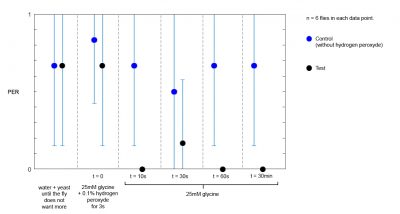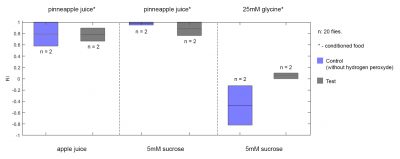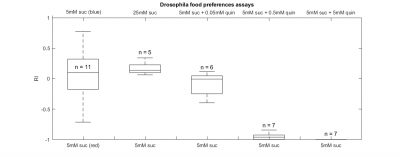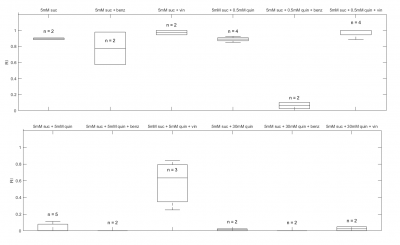Drosophila behavioural flexibility towards food (3)
on Saturday, February 11th, 2017 10:21 | by André Silva
This time I tried to induce a kind of Garcia effect (eating something, feeling sick and then avoiding eating that again) in Drosophila. As one can see in the video below, Drosophila show inhibited proboscis extension response (PER) right after the onset of the US (intestinal discomfort).
However, the conditioned response is extinguished after several hours. I tried to use groups of 20 starved flies on yeast+water for 2h, food + 0.1% hydrogen peroxyde for 1h, starving with nothing for 1h (always inside vials), and then testing with conditioned food against another food for 2h (inside Petri dishes). It didn’t work: in the end they show the same preference as controls (without hydrogen peroxyde). I tried to condition sucrose, glycine, pineapple juice (and then test against apple juice) and nothing, the flies avoid at first but once the swelling goes away, they forget or don’t associate anything bad or sufficiently bad with that food anymore, and continue to prefer it.
I also confirmed the PER suppression following conditioning with quinine reported in [C. Keene A, Masek P. Optogenetic Induction of Aversive Taste Memory. Neuroscience. 2012;222:173-180]. However, it is also extinguished minutes (~30) after the conditioning, as their results also show (in my case, I used sucrose instead of fructose):
(my results:)
Category: Food preference, Spontaneous Behavior | No Comments
Drosophila behavioural flexibility towards food (2)
on Thursday, February 2nd, 2017 9:49 | by André Silva
This time I tested how the behaviour changes with the proportion between the positive stimulus (sucrose) and the negative stimulus (quinine) and how it changes with the presence of a positive odour (vinegar) or a negative odour (benzaldehyde).
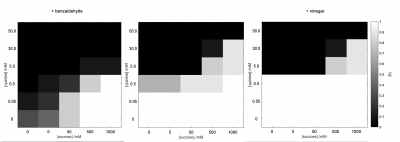
Category: Food preference, Spontaneous Behavior | No Comments
Drosophila behavioural flexibility towards food
on Saturday, January 28th, 2017 12:05 | by André Silva
Why does one choose a burger over a carrot? How much is it possible to change that choice? What can Drosophila tell us about it?
I wanted to study Drosophila spontaneous behaviour regarding their food preferences and how malleable it is, so I can then try to condition it – and one should notice that those are “preferences” and therefore not neutral CS to begin with, as usual.
For that I used wild type Drosophila starved for 24 hours.
Drosophila likes the sweetness and the nutritional value of sucrose and does not like the bitter taste of quinine. Vinegar is a well-known attractant and benzaldehyde a well-known repellent.
To test the food preferences I simply add different food colouring to the food, test the flies in Petri dishes with alternated 10µL food drops and then, after 2h at 25°C and without light, I freeze them and count the number of flies based on the colour of their abdomen:
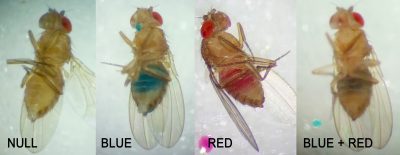
Here I present my first results:
(n = number of trials, each using 40 flies.)
As an illustration, here I have a short video showing a few flies during their initial food exposure:
And here the results with food in the presence of odours:
(The odours were placed in a small piece of filter paper inside the Petri dish.)
Next I would like to see if I can change their preferences (using these foods or sucrose vs fructose, etc.) through conditioning (as in the Garcia effect). Suggestions are welcomed.
Category: Food preference, Spontaneous Behavior | No Comments

